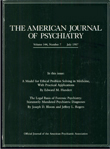ECT Failure Rate Among Specific Devices
To the Editor: In reporting that adequate ECT seizures were not obtained at the maximum electrical stimulus dose in 5% of ECT patients, Andrew D. Krystal, M.D., M.S., et al. (1) did not recognize that this result is limited to the MECTA Corporation ECT device they used. Instead, they suggested that their results apply to all devices: “Approximately one of six patients…required the maximum possible ECT stimulus intensity available on U.S. ECT devices” (p. 965). The result is limited to MECTA devices because the pulse width and frequency of the maximum stimulus they use are specific to MECTA devices, and their values are crucial to the reported study. These values are for a 2.0-msec pulse width and a 90-Hz frequency with a 2.0-sec duration and 0.8 A current. Compared to these values, the combination of a narrower pulse width, lower frequency, and longer duration should produce lower rates of failure for seizure induction (2, 3). The point that a 5% failure rate is needlessly high is indisputable. However, the failure rate should be substantially lower with more efficient electrical stimuli as well as with higher doses.
Dr. Krystal et al. repeatedly noted a “maximum stimulus intensity limitation of 576 millicoulombs (mC) imposed on U.S. ECT devices by the Food and Drug Administration (FDA)” (p. 963). The actual limitation is 100 J of energy at 220 Ω of impedance. For 0.8 A current, as used in MECTA devices, this limitation corresponds to 572 mC. The original source for a figure of 576 mC is MECTA’s commercial literature. I also wish to point out that nowhere in their published article do Dr. Krystal et al. note their relationship with MECTA Corporation.
The author is a member/manager of Somatics LLC, a maker of ECT instruments.
1. Krystal AD, Dean MD, Weiner RD, Tramontozzi LA III, Connor KM, Lindahl VH, Massie RW: ECT stimulus intensity: are present ECT devices too limited? Am J Psychiatry 2000; 157:963–967Google Scholar
2. Swartz CM, Larson G: ECT stimulus duration and its efficacy. Ann Clin Psychiatry 1989; 1:147–152Crossref, Google Scholar
3. Swartz CM, Manly DT: Efficiency of the stimulus characteristics of ECT. Am J Psychiatry 2000; 157:1504–1506Google Scholar



